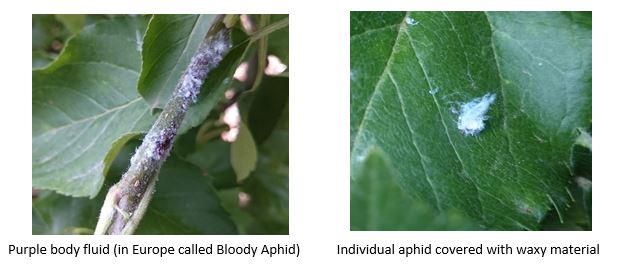During this season, many growers have experienced the occurrence of white cotton-like masses on leaves, limbs, shoots, pruning wounds, above-ground portions or roots and trunk in some of their blocks. These white cotton-like masses represent a serious pest of apples in Australia called Woolly Aphid. Speaking with growers all around Victoria, we have found out that over the past decade the prevalence of woolly apple aphid appears to be increasing.
There are many factors and management production changes which contribute to providing a more favourable environment for the development of the aphid, such as susceptible varieties and rootstocks, inappropriate IPM strategy, insecticide resistance, use of unselective insecticides which have negative effect on predators, increased fertilization etc.
Besides causing direct damage to fruit and general tree health, wool-like waxy material which covers their body also has an effect on orchard operations – particularly summer pruning, thinning and harvesting.
Honeydew, a sugar-rich fluid produced by the woolly aphid can drip onto the fruit resulting in sooty mould and the downgrading of fruit because of blackened or russeted areas. High populations of woolly apple aphid can create sticky and unpleasant working conditions for harvest crews, leaving purple stains on skin and clothing. This stickiness and the woolly filaments make orchard operations very uncomfortable.
Woolly aphid overwinters as an early-stage nymph called a crawler in cracks and crevices in the bark; most disperse to the base of the tree and infest the roots. While feeding on the roots, crawlers cause large galls to form. When spring approaches, crawlers migrate to tree canopy. Crawlers migrate between roots and shoots throughout the season but as winter approaches those moving to the roots form dormant colonies.
Comparing to root colonies, aerial colonies are often kept under control by insecticides application for other pests such as codling moth. It is very important to monitor the orchard to determine which trees should be treated with a soil drench. Every tree colonized by woolly aphid marked for treatment early the following season.
Waxy covering provides protection from some of insecticides. Therefore, in order to break surface tension of waxy material and allow insecticides to get in contact with pests, it is usually recommended on the label to add specific surfactant to tank mix. Due to some of the properties of surfactants (penetration and drying), most of organosilicon surfactants have some insecticidal effect on soft body insects such as woolly aphid. High volume applications of recommended insecticides may be necessary to penetrate the wax.
Failure to control aerial infestations can result in underground infestations on susceptible rootstocks. In order to control root colonies, an insecticide, registered for use as soil drenches should be applied. A soil drench can be used on trees up to 7 years old. Timing is critical, and the application needs to be made between green tip and petal fall. In order to obtain efficient woolly apple aphid control it is important that the active roots can take up sufficient quantity of product. This is achieved by ensuring soil are moist prior to application, preventing the product from running away from the treated area and ensuring the application zone is weed free.
Resistant rootstocks provide the best defence against underground infestations. The Merton-Malling (MM) series is resistant to woolly aphid. MM102 provides an option for orchardists with high-density blocks where woolly aphid is likely to become a problem on more susceptible varieties.
Woolly aphid has several natural enemies such as earwigs, lacewings and ladybirds but is more frequently parasitised by Aphelinus mali, a small parasitic wasp. A. mali plays a major part in suppressing woolly aphid populations, but their effectiveness depends on selectivity of pesticides used in production as beneficial organisms are generally more susceptible to chemicals than the target pest species. Furthermore, when compared to woolly aphid, this predator requires higher temperatures to initiate its development, therefore aphid colonies caused damage prior to the wasp becoming active.
By Petar Bursac, FGVL Industry Dev. Officer.




